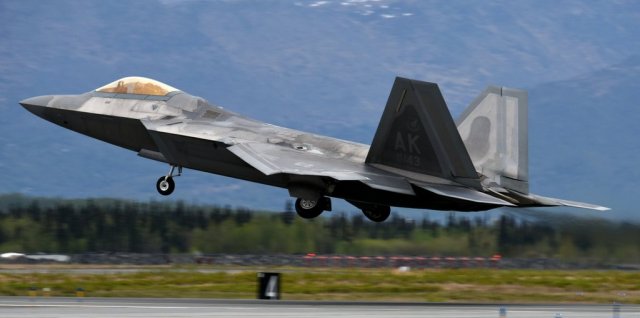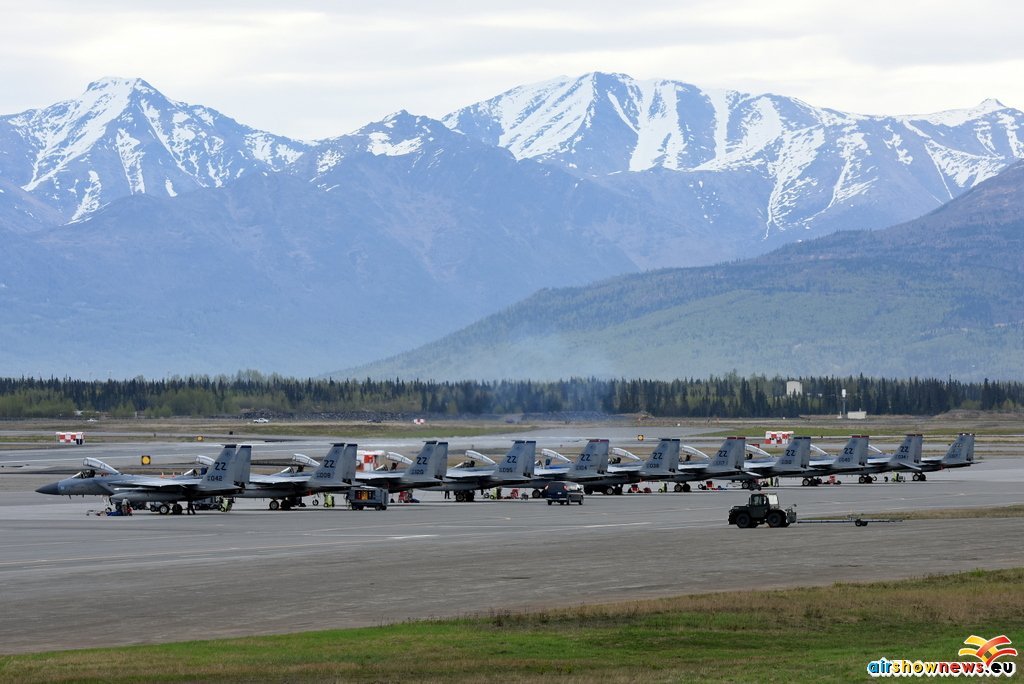
Elmendorf and Eielson AFB, Alaska, USA, 30/4-15/5 2015
Report by Aidan Curley
Three times a year Red Flag Alaska (RFA) military exercises are held at the two main bases of Eielson and Elmendorf-Richardson just outside Fairbanks and Anchorage respectively. Originally named Cope Thunder, the Pacific Air Forces sponsored exercise was moved to Eielson from Clark Air Base, Philippines in 1992 after the eruption of Mount Pinatubo on June 15, 1991 forced the curtailment of operations. Cope Thunder was re-designated Red Flag Alaska in 2006.
Prior to Operation Desert Storm, less than 20% of the U.S. Air Force’s primary fighter pilots had seen actual combat. While the percentage of combat-experienced pilots has increased in recent years, there are still a significant percentage of pilots that have no combat experience. Analysis indicates most combat losses occur during an aircrew’s first eight to 10 missions; therefore the goal of Red Flag Alaska is to provide each aircrew with these first vital missions increasing their chances of survival in combat environments.
Red Flag Alaska participants are organized into “Red” aggressor forces and “Blue” coalition forces. The Red force includes air-to-air fighters, ground-control intercept, and surface air defence forces to simulate threats posed by potentially hostile nations whilst the Blue force comprises U.S. and Allied tactical & support units. The job of controlling the mock war and ensuring safety falls to the “White” neutral controlling force.
Although the exact mission details remain classified, during the two-week deployment phase of the exercise aircrews are subjected to many different combat threats with different scenarios being developed to meet each exercise’s specific training objectives. It is normal for up to 70 jet fighters to be operating in the same airspace at one time and typically there are two combat training missions each day, in the morning and afternoon with each fighter squadron usually flying between 6 and 8 aircraft in each mission package.
Red Flag Alaska 15-2 took place 30 April – 15 May, 2015 and involved over 100 aircraft operating from the 2 bases. These Units were operating from Eielson:
- 354 FW / 18 AGRS F16C/D 13 aircraft noted participating, based Eielson, AK
- 113 WG / 121 FS F16C/D 10 aircraft deployed from Andrews, MD
- 180 FW / 112 FS F16C/D 10 aircraft deployed from Toledo, OH
- 93 FS F16C/D 11 aircraft deployed from Homestead, FL
- 35 FW F16C/D at least 16 aircraft deployed from Misawa, Japan
- 128 ARW / 126 ARS KC135R 2 aircraft deployed from Milwaukee, WI
- 92 ARW / 141 ARW KC135R 3 aircraft deployed from Fairchild, WA
- 22 ARW / 931 ARG KC135R 2 aircraft deployed from McConnell, KS
- 171 ARW KC135T 1 aircraft deployed from Pittsburgh, PA
Non-US Units are frequent participants in these exercises too, however for RFA 15-2 the foreign forces were limited to just the Royal Canadian Air Force with a single KC130T from 435 Sqn and 10x CF188A/B from a mix of squadrons (409, 410, 425 Sqn).
There were also visits from a KC135R from the 154 WG / 203 ARS (Hickam, HI) supporting 3 B52Hs from the 2 BW (Barksdale, LA) which had temporarily relocated from Guam due to bad weather. Sadly there was no opportunity to photograph the B52s.
In addition the following participants were operating from Elmendorf where unfortunately the sunshine experienced at Eielson had been replaced by grey skies:
- 18 WG F15C/D at least 11 aircraft deployed from Kadena, Japan
- 3 WG F22A 19 aircraft noted participating, based Elmendorf, AK

There were also an unknown number of other aircraft involved in a support role outside of combat operations including at least C130 and E3 from Elmendorf and Rescue HH60G available from Ft Richardson plus a C21A Learjet carrying VVIPs visiting Eielson on 13th May. No doubt there would have also been several C130 and C17s moving personnel and equipment at the start and end of the deployments as well.
2016 should see the first of two F-35 squadrons being established at Eielson with an eventual total force of 48 aircraft operating alongside the 21 F-16s of the 354th FW. With excellent ranges nearby, a sparse and supportive local population and plenty of ramp space for participating aircraft with housing for deployed personnel then the future looks bright for the well-established RFA programme.





















